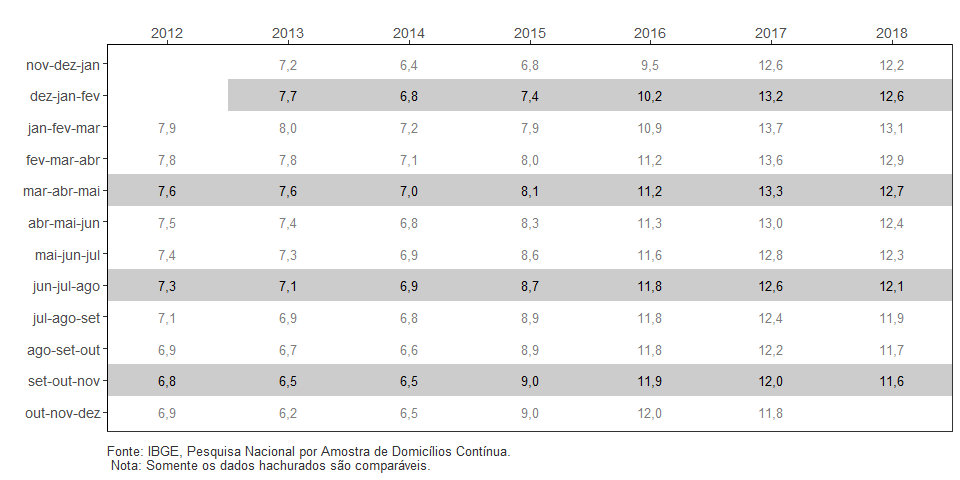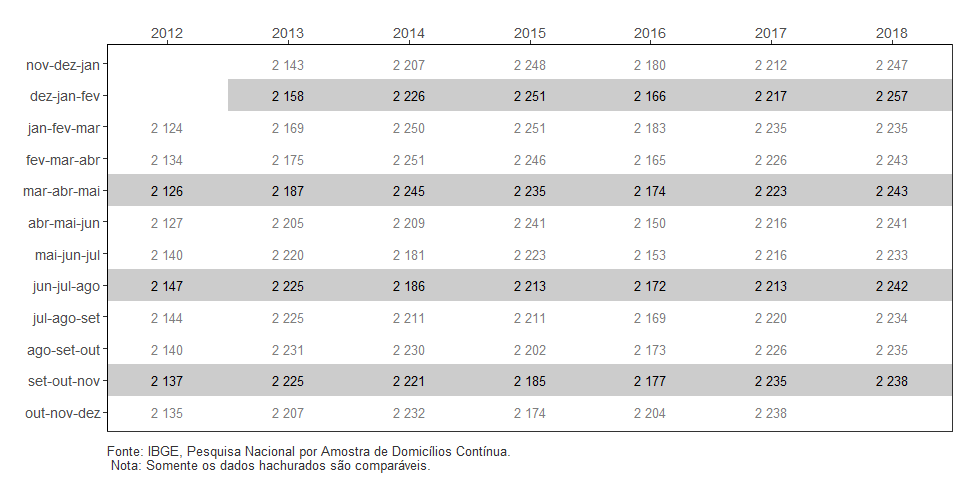Continuous PNAD: unemployment rate is 11.6% and underutilization rate is 23.9% in quarter ended in November 2018
December 28, 2018 09h00 AM | Last Updated: January 02, 2019 12h18 PM
The unemployment rate (11.6%) retreated -0.5 percentage points in the moving quarter ended in November 2018 in relation to the quarter from June to August 2018 (12.1%). Compared with the same moving quarter of 2017 (12.0%), it dropped -0.4 percentage points.
| Indicator/Period | Sep-Oct-Nov 2018 | Jun-Jul-Aug 2018 | Sep-Oct-Nov 2017 |
|---|---|---|---|
| Unemployment rate | 11.6% | 12.1% | 12.0% |
| Underutilization rate | 23.9% | 24.4% | 23.7% |
| Usual real earnings | R$2.238 | R$2.242 | R$2.235 |
| Change in the usual real earnings in relation to: | -0.2% (stable) | 0.2% (stable) | |
The unemployed population (12.2 million) fell -3.9% (less 501 thousand persons) against the quarter from June to August 2018. It reduced -2.9% (less 364 thousand persons) in the comparison with the same quarter of 2017.
The employed population (93.2 million) was the highest in the time series started in 2012, increasing 1.2% (more 1.1 million persons) over the quarter between June and August 2018 and 1.3% (more 1.2 million persons) over the same quarter in 2017.
The underutilization rate of the workforce (23.9%) retreated -0.5 percentage points in relation to the previous quarter (24.4%). No statistically-significant change was registered in the comparison with the same quarter in 2017 (23.7%).
The underutilized population (27.0 million) reduced -1.7% over the quarter from June to August 2018 (less 478 thousand persons). In relation to the same quarter of 2017, this group grew 1.8% (more 486 thousand persons).
The number of discouraged persons (4.7 million) remained stable in relation to the quarter between June and August 2018 and increased 9.9% in relation to the same quarter of 2017 (4.3 million). Thepercentage of discouraged persons (4.3%) remained stable in relation to the previous quarter and increased 0.3 percentage points in the comparison with the same quarter of 2017 (3.9%).
The contingent of persons employed in the private sector with a formal contract (excluding domestic workers) was 33.0 million persons, staying stable in both comparisons. On the other hand, the number of persons employed without a formal contract (11.7 million) was the highest in the time series and increased in both comparisons: 4.5% compared with the previous quarter (more 498 thousand persons) and 4.7% (more 522 thousand persons) in relation to the same quarter of 2017. The category of self-employed workers (23.8 million) also hit its highest contingent in the time series, with rises of 2.3% in the comparison with the previous quarter (more 528 thousand persons) and of 3.3% in relation to the same quarter of 2017 (more 771 thousand persons).
The average usual real earnings (R$2,238) did not change in both comparisons, as well as the usual real wage bill (R$203.5 billion).
The unemployment rate was 11.6% in the moving quarter ended in November 2018, having retreated -0.5 percentage points in relation to the quarter from June to August 2018 (12.1%). Compared with the same moving quarter of 2017 (12.0%), it dropped (-0.4 percentage points).
12.2 million persons were unemployed in Brazil in the quarter from September to November 2018. This contingent fell -3.9% (less 501 thousand persons) against the quarter between June and August 2018. Compared with the same quarter of 2017, this estimate declined -2.9% (less 364 thousand unemployed persons in the workforce).
Chart 1 - Unemployment Rate - Brazil - 2012/2018

The compound rate of labor underutilization - percentage of unemployed persons or time-related underemployed persons or persons in the potential workforce in relation to the extended workforce - was 23.9% in the moving quarter from September to November, representing a drop of -0.5 percentage points over the previous quarter (24.4%). It remained stable compared with the same quarter of 2017 (23.7%).
Compound rate of underutilization of the workforce – quarters from August to October – 2012/2018 Brazil (%)

Nearly 27.0 million persons were underutilized in Brazil in the quarter from September to November 2018. This contingent fell -1.7% (less 478 thousand persons) against the quarter between June and August. Compared with the same quarter of 2017, this estimate grew 1.8% (more 486 thousand underutilized persons).
The contingent of time-related underemployed persons (7.0 million) increased 4.7% in relation to the previous quarter (more 317 thousand persons). It increased 8.8% (more 570 thousand persons) over the same quarter of 2017.
The contingent out of the workforce (65.1 million persons) did not change over the previous quarter. Compared with the same quarter of 2017, it expanded 1.1% (more 696 thousand persons).
The contingent of discouraged persons (4.7 million) was stable in relation to the previous quarter and increased 9.9% in relation to the same quarter of 2017.
The percentage of discouraged persons in relation to the population in the workforce or discouraged (4.3%)remained stable over the previous quarter and increased 0.3 percentage points against the same quarter of 2017 (3.9%).
The contingent in the workforce – employed and unemployed persons – in the quarter from September to November 2018, was estimated at 105.4 million persons. It rose by 607 thousand persons (0.6%) compared with the previous quarter. It expanded 0.8% (increase of 876 thousand persons) over the same quarter a year ago.
The number of employed persons (93.2 million) increased 1.2% (more 1.1 million persons) over the quarter between June and August 2018 and 1.3% (1.2 million persons) compared with the same quarter of 2017.
The employment-population ratio – percentage of employed persons at working age – was estimated at 54.7% in the September-November quarter of 2018, a rise of 0.5 percentage points over the previous quarter (54.1%.). No statistically-significant change was registered in relation to the same quarter of 2017 (54.4%).
The number of persons employed in the private sector with a formal contract (excluding domestic workers) was 33.0 million persons, staying stable in both comparisons.
The number of persons employed in the private sector without a formal contract (11.7 million) was the highest one in the time series started in 2012, having increased in both comparisons: 4.5% compared with the previous quarter (more 498 thousand persons) and 4.7% (more 522 thousand persons) in relation to the same quarter of 2017.
The number of self-employed workers (23.8 million) was also a record in the time series, having risen 2.3% in the comparison with the previous quarter (more 528 thousand persons) and 3.3% in relation to the same quarter of 2017 (more 771 thousand persons).
The category of the employers (4.5 million persons) remained stable both in relation to the previous quarter and to the same quarter last year.
The group of domestic workers (6.3 million persons) remained stable when compared with the previous quarter and also with the same quarter of 2017.
Estimated at 11.8 million persons, the group of those employed in the public sector – including statutory servants and military – remained stable in both comparisons.
The average usual real earnings from all jobs of employed persons (R$2,238) remained stable in both comparisons.
Average monthly usual real earnings from all jobs of employed persons - Brazil - 2012/2018 - (R$)


